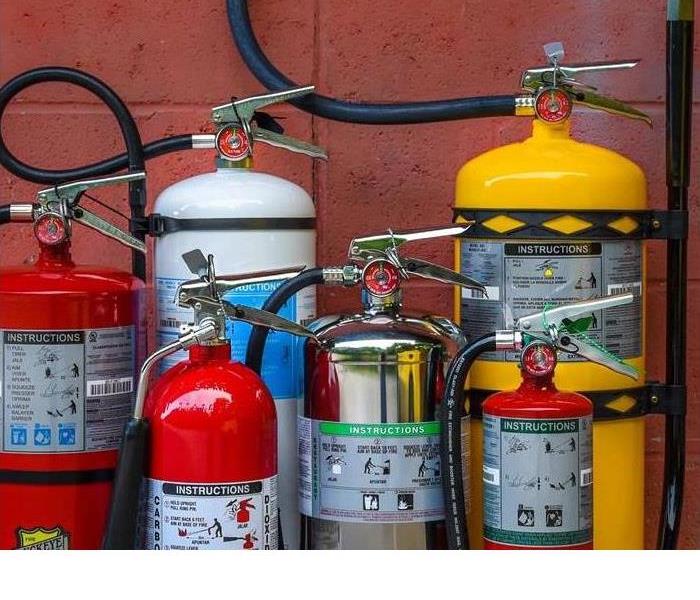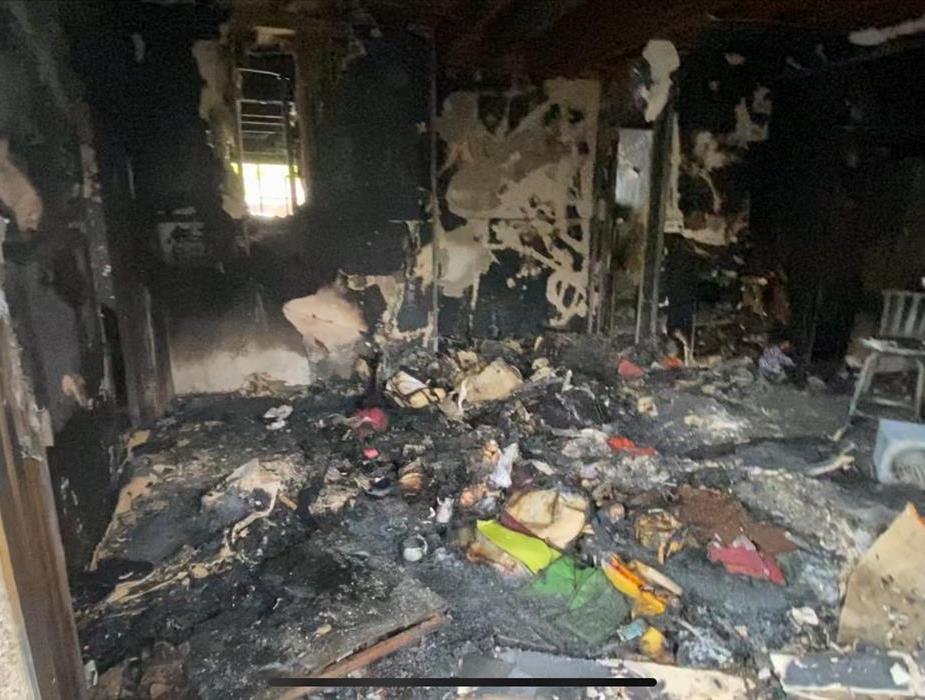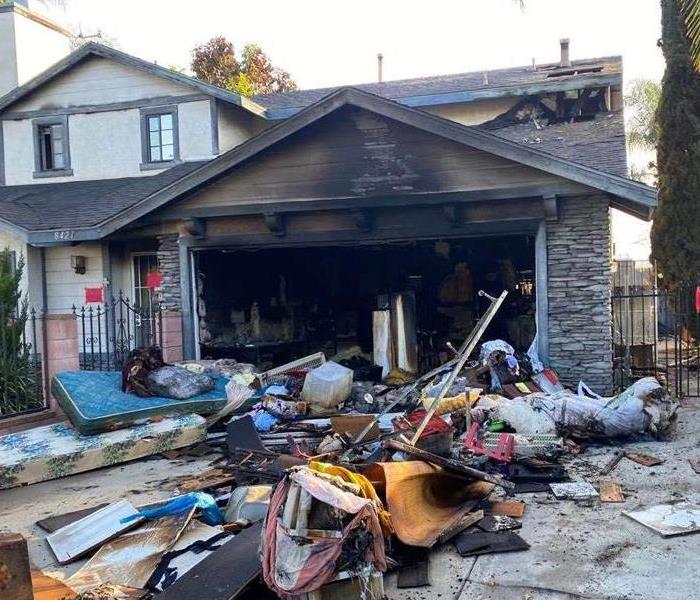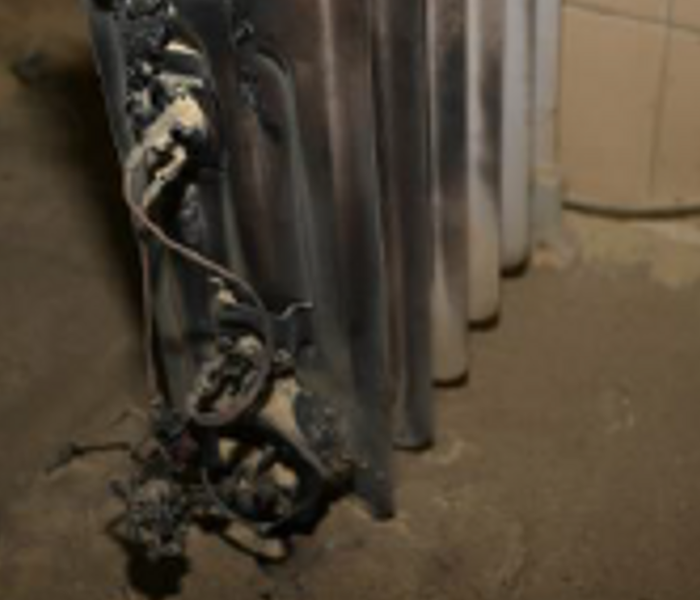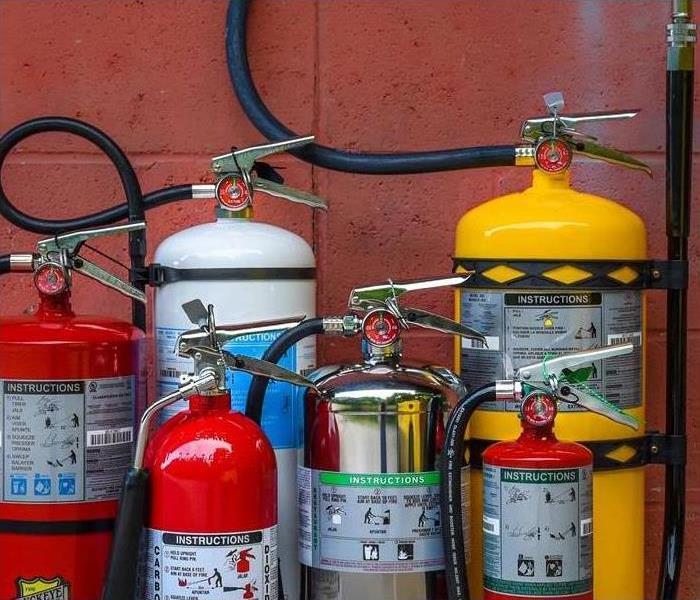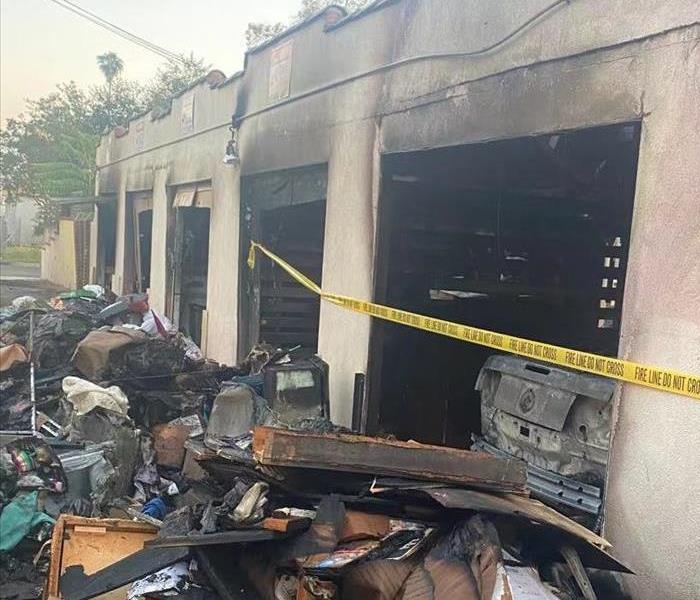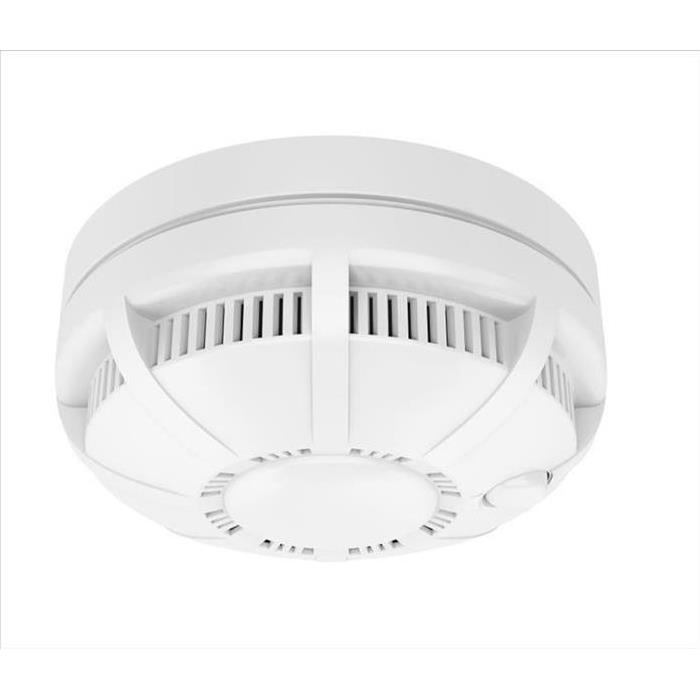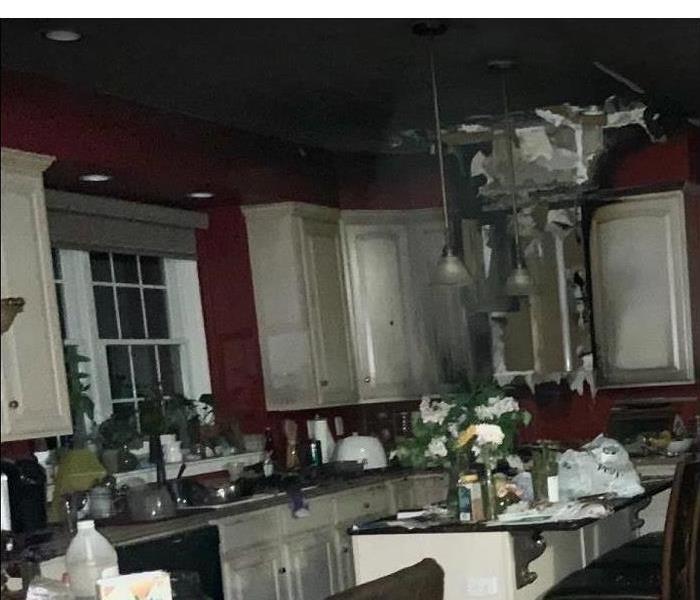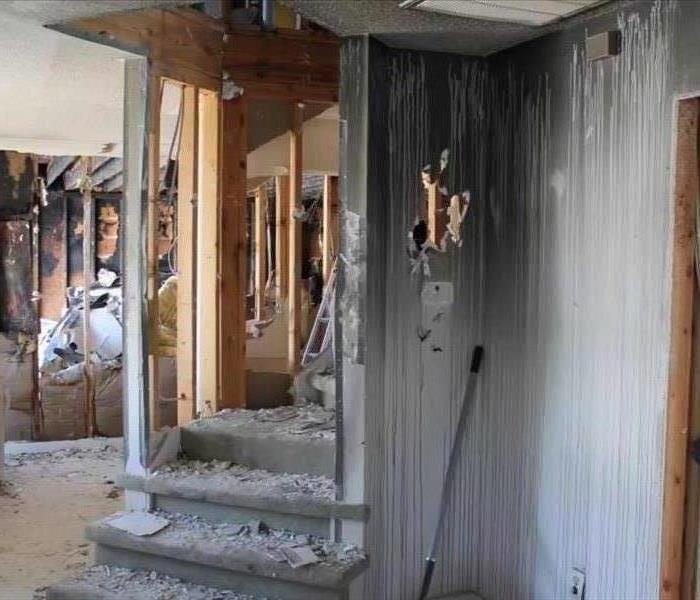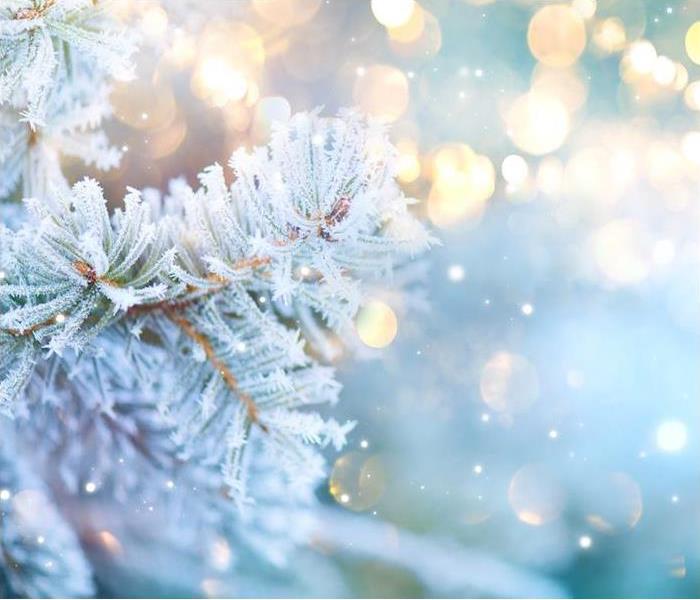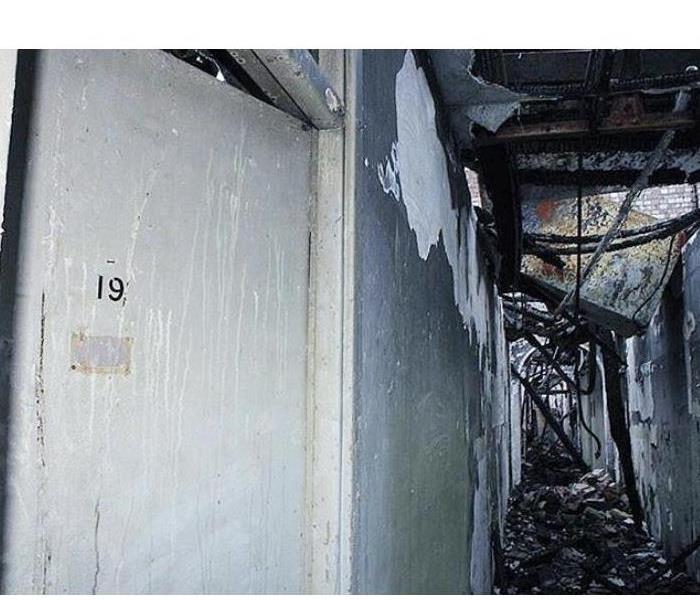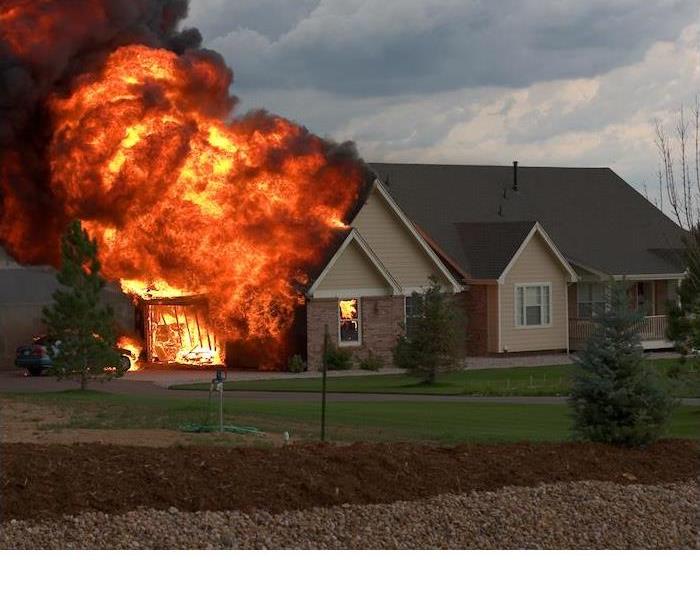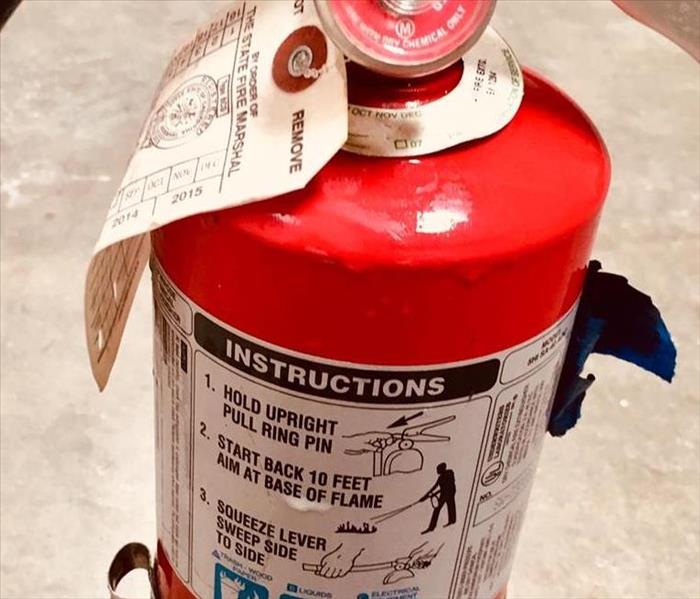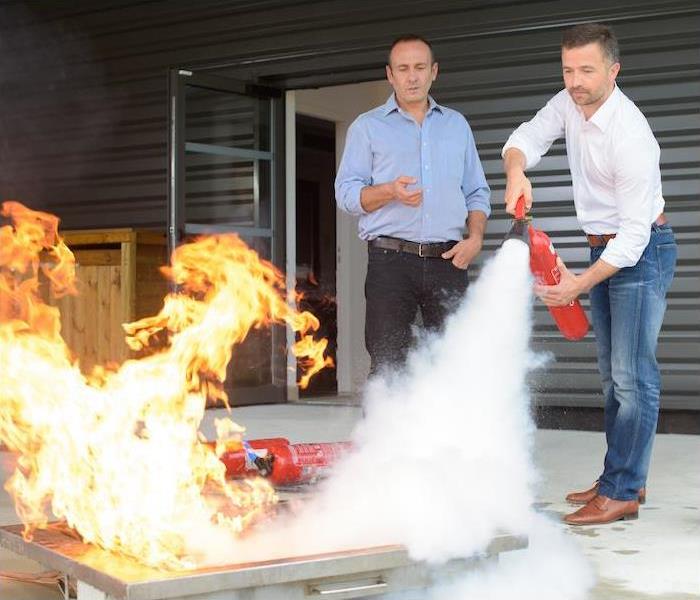Recent Fire Damage Posts
Proper use and deployment of your Fire extinguisher
9/15/2022 (Permalink)
Do you have a working fire extinguisher. It is imperative that your designated fire extinguishers have the correct pressure and have been inspected and certified annually
Do you know how to properly deploy and use your fire extinguisher?
These are the steps for using a fire extinguisher.
First, you want to make sure you have the correct fire extinguisher. In most settings, an ABC class extinguisher is most common. An ABC extinguisher puts out most fires including:
Class A fires – common materials including wood which typically produce Ashes.
Class B fires – flammable liquids that are typically stored in a Barrel, such as gasoline.
Class C fires – electrical fires that have an electrical Current
Fires that require a more specialized type of extinguisher include class D fires which are flammable metal or class K fires which are high temperature cooking oil fires.
The steps for using a fire extinguisher are:
P: Pull the pin that prevents the extinguisher from discharging accidentally.
A: Aim the nozzle at the base of the fire
S: Squeeze the handle/trigger to discharge the extinguishing agent
S: Sweep the nozzle back and forth to cover the burning material
Fire Clean up in San Gabriel CA
6/16/2022 (Permalink)
Knowing the Obstacles of Restoration, SERVPRO Professionals will professionally asses and guide you though the process of post fire restoration.
Property inspections help our team to see where immediate action is necessary. Identifying the type of smoke and soil damage in this inspection can ensure the right tools are available for mitigation and cleanup.
What Types of Smoke Damage Exist After Combustion?
The materials burned before clean up begins can directly impact the residues involved and the composition of soils that threaten the household. Some include:
- Wet Smoke – Wet smoke damage is often among the most challenging, as it is thick and cannot be cleaned with chem sponges or traditional cleaning measures.
- Dry Smoke – High heat fires that do not leave many partially combusted materials can create dry smoke damage. This looks like a chalky film on surfaces that can often be wiped clean.
- Oil/Puffback Damage – With many area residences running furnaces that use oil as fuel, puff back damage is not uncommon. These micro explosions in your duct network can leave surfaces coated in stringy soot.
- Protein Residues – These are common to see after kitchen/grease fires. Protein Residue can be thick and challenging to remove and carry a powerful odor with them that spreads.
Understanding the type of fire and smoke damage in your home after a disaster can be critical in identifying the best cleaning and restoration approach. SERVPRO of San Gabriel team can help with efficient cleaning solutions based on the composition of soils. Give us a call today at 626-478-0286
Fire clean up, Los Angeles County
6/16/2022 (Permalink)
SERVPRO Provides Fire Damage Restoration Services in San Gabriel and Temple City, CA
Anyone who has ever suffered from a fire on their property knows that it can be devastating and create quite a mess. The flames, of course, can torch anything it comes into contact with, and the smoke released can also cause problems. Smoke can travel to areas in your home far away from the fire's source and leave behind soot residues.
Our SERVPRO technicians often spend a good portion of their time cleaning soot residues from your contents and building materials during fire damage in Los Angeles County. Since the various types of smoke can cause different issues, we have an array of chemicals and cleaning methods we use during the remediation process.
We Can Offer Several Services to Return Your Home to its Pre-damaged State
- Content Cleaning
- Smoke Remediation
- Fire Damage Debris Removal
- Fire Cleanup
- Fire & Water Damage Restorations
- Structural Deodorization
When cleaning soot residues from your contents and building materials, some of the cleaning procedures work by chemically altering the soot residues. When our SERVPRO technicians use strong acids, bleaching, enzyme digestion, or oxidizing, chemical changes occur that help us remove the soils. Enzymes are living organisms that digest soot made from protein like burnt food. The enzymes turn the soot particles into soluble molecules that can be cleaned using detergents, water, or ammonia solutions.
When cleaning soot residues from the surfaces of items in your house, we can use two types of bleaching agents. Oxidizing bleaches add oxygen to a soil that changes its chemical structure and breaks it down. Reducing bleaches (or strippers) work the opposite and can neutralize the effects of an oxidizing agent.
If you ever notice soot residues on your walls or furniture after a fire, call us at 626-478-0286
Fire Risks from Space Heaters
6/2/2022 (Permalink)
It is reported that there are about 25,000 residential fires a year in the United States from the use of space heaters in the home.
Space heaters should be setup at least a three feet away from any thing that can catch fire such as furniture, boxes, paper or other combustible items. Check your space heater equipment often and clean it regularly.
If you have any doubt replace it. New space heaters have more safety features then old ones. It is a good idea to unplugged the space heater whenever not in use or when you leave your home.
Cleaning your space heater can be done by blowing compressed air throughout the inside and vents to get rid of dust and debris that may accumulate and wiping down where you can. You may need to remove the front cover to do so.
A good source for safety information regarding space heaters is ESFi (The Electrical Safety Foundation International)
If you have had a fire in your home call SERVPRO of San Gabriel 626-478-0286
What Requires Cleaning During Fire Restoration in San Gabriel, CA?
5/31/2022 (Permalink)
Post Fire restoration Call SERVPRO of San Gabriel
Cleaning is a typical restoration task after a fire incident. Although many people know this, many do not appreciate the full extent of cleaning work needed to restore the house to its preloss state. It is easy to underestimate the resources needed for the task.
Most of the cleaning effort during properties is likely to be expended on the removal of smoke residues. Such residues accumulate on uncovered surfaces such as walls and ceilings and hidden areas such as wall cavities and cabinet interiors. Hidden sections are likely to have more residues since convection currents tend to move smoke towards colder areas of the structure.
Before starting restorative cleaning We offer services such as:
- Content cleaning using regular and specialized methods such as ultrasonic cleaning
- Removal of materials such as insulation since cleaning them is not cost-effective.
- Surface cleaning using diverse methods including vacuuming, wet cleaning, or even soda blasting
SERVPRO of San Gabriel handles cleaning tasks regularly during fire restoration. Call us whenever you need assistance at (626)-478-0286
Fire Season is here
5/17/2022 (Permalink)
As the weather becomes warmer and drier, the chances of a home fire increases as well. It’s important to do a good preventative check around the house, to remove broken appliances, correct outlets with too much plugged in, and worn down wires. Even with such preventative measures.
If a Fire Starts:
- Use a fire extinguisher. Practicing with your family on the proper use of one ahead of time could make a huge difference, in saving lives, damage to the home, and money.
- If the fire catches on your person (clothes, etc.) STOP, DROP, AND ROLL.
- If the fire is uncontrollable, get out of the house immediately, and call 9-1-1. Do not go back to gather any belongings.
- Important to use stairs, not an elevator, during a fire. A fire can cause the electricity to go out in a building. The elevator quarry can fill up quickly with smoke.
- If you are trapped inside, close doors around you, placing wet towels at the bottom of the door, call 9-1-1, and tell the operator where you are located.
After the Fire
After a fire, it’s crucial that you contact SERVPRO Of San Gabriel, the professional fire damage restoration company in your area. Don’t try cleaning up the damage on your own, because you could make things worse. We are highly trained, fully equipped, and ready to properly restore your home - "Like it never even happened."
Trust the experts, call/text us today at 626-478-0286
Commercial garage fire Los Angeles CA
9/15/2021 (Permalink)
Professional Fire Damage Restoration and Clean Up
No one expects a fire to race through their homes or commercial properties. But When it happens it is critical to work with a company that understands and has decades of experience in working with fire clean up and restoration.
Clearing out fire damage in San Gabriel Valley homes takes specialized training and equipment. At SERVPRO San Gabriel. Our members are trained to become Fire & Smoke Damage Restoration Technicians. We know how to use every chemical and tool in our inventory to clean and restore any space after a fire.
After the initial clean up of the fire damaged property, our team begins the meticulous task of wiping down every surface to remove smoke residues and odors. Getting the space ready for reconstruction is our goal.
Post fire Check list
- Having your insurance information ready for us would help speed up the process. That includes the name of the company, its phone number, your policy number, and the report from the insurance adjuster.
At SERVPRO of San Gabriel CA, our goal is to restore every home to its pre-fire condition. If your home has suffered through any size fire, call us at (626) 478-0286 today to begin the repair and restoration process.
Questions You n Need Ask Yourself as You Make Sure Your Home Is Protected
4/26/2021 (Permalink)
You don't think much about the fire alarms in your home in until they start chirping or go off when you burn toast. These alarms are vital to protecting you and your family from a fire, though. Whether it's alerting you to a life-threatening blaze or reducing the amount of fire damage from an unnoticed kitchen flare-up, your home's fire alarms are vital to helping you avoid heartache.
1. Do You Have Enough?
You should have at least one fire alarm on every floor of your home, plus one in each bedroom and one outside every sleeping area. Inspect your home to make sure you have the right number, and consider adding additional units.
2. Do They Work?
Chirping alarms ensure that you're replacing the batteries regularly, but you'll also need to replace your fire alarm unit entirely every 8-10 years or so since their sensors eventually wear out. Sometimes the units will alert you of this, but often you'll just need to keep track of when they were installed.
3. Are They Effective?
In addition to making sure that your fire alarms are functional, it's important to know that they are effective. For example, there are two different types of smoke detectors: One that picks up on hot blazes (an ionization alarm) and one that warns you about smoky, smaller fires (a photoelectric alarm). To make sure that you're covered for both types of fires, make sure you have both types of alarms installed throughout your home or alarms that detect both.
Although a fire alarm can't prevent a fire or prevent the need to clean up from smoke damage.
Time! Fire alarms give you and your family the critical time needed to escape from a fire.
What Should I Do if a Fire Burns My San Gabriel, CA Ceiling and Attic?
4/16/2021 (Permalink)
For Fire Damage Mitigation Inside Your in San Gabriel, CA Call SERVPRO
Once flames light up inside your San Gabriel home, the heat will rise, and the blaze will start torching your building materials that are above the initial source. Commonly, an inferno can engulf the components that make up your ceiling, attic, and roof.
How can you tell what materials will have to be removed and what can be saved?
During every fire damage project in San Gabriel, whether or not your structural components will have to be removed and replaced depends on how severely the item got burnt and how deep the charring went. Our SERVPRO technicians can conduct a thorough inspection of your building and determine which items we think we can save through sanding or sandblasting, refinishing, cleaning, and sealing. When the flames have consumed sections of your ceiling and made their way into your attic, we inspect the following building materials for issues:
• Acoustic Ceiling Tiles and Drywall- In most cases, if your ceiling tiles or drywall got anything more than just surface charring, the materials must be removed. In this case, we can remove just the burnt pieces of your ceiling and dispose of them in sealed plastic bags. If other parts of your sealing are coated in soot residues, then we can clean them with dry sponges or wet cleaning techniques.
• Insulation- If the insulation inside your attic got burned during the fire, in most cases, it must get removed. If your insulation is just smoke-damaged, it can be deodorized, but it is usually more cost-effective to remove and replace it.
• Trusses- When determining whether we can save your affected roof trusses or not, we follow the general quarter inch rule. If the charring is less than a quarter-inch deep, then we can sand down or sandblast the charring off. As a final step, we can then apply a specialized sealant paint to your entire attic to seal in any foul odors.
Call SERVPRO of San Gabriel at (626) 478-0286 24/7.
San Gabriel, CA Homeowners can Count on SERVPRO to Restore Instead of Replacing When Possible
4/16/2021 (Permalink)
Smoke odors can quickly penetrate wood furniture. Pieces such as desks and coffee tables have unfinished sections such as drawer bottoms, backs, and undersides. Restoration depends on the material and the extent of the fire.
SERVPRO provides fire restoration in San Gabriel, CA with the goal of restoring as much as we can. We do not replace unless we have to do so. Our crew uses various cleaning techniques depending on the type of soot they are cleaning. Denatured alcohol and dry-cleaning sponges are two standard tools employed. Some signs indicate the item is beyond restoration:
- Extensive surface blistering
- Waterlogged joints
- Cracked joints from intensive heat
- Permanent staining
- Severely charred areas
Fires don't have to be big to cause damage. Contact us at (626) 478-0286 for all your fire, water, and flood restoration needs. We’re Faster To Any Size Disaster.
Fire Safety Tips for Your Business
4/15/2021 (Permalink)
As a business owner, there are plenty of safety considerations to address regarding risks to your business, staff and visitors. One of the things you need to spend a little extra time planning for and working toward is fire prevention.
According to the National Fire Protection Association (NFPA) listed in order:
- Cooking equipment, 29% of fires
- Electrical distribution and lighting equipment, 12% of fires
- Heating equipment, 11% of fires
- Intentional, 10% of fires
- Smoking materials, 9% of fires
- Exposure, 4% of fires
- Electronic, office or entertainment equipment, 3% of fires
From those cases, three of them—intentional, exposure, and electrical distribution and lighting equipment—accounted for 20%, 18% and 15%, respectively, of the most property damage.
The Bureau of Labor Statistics found that in 2007, fires and explosions accounted for 3% of all workplace fatalities.
In taking a looking at more recent numbers, the NFPA estimates that from 2007–2011, U.S. fire departments responded to an average of 3,340 fires in office properties per year, which were responsible for an annual average of four deaths, 44 injuries and $112 million in direct property damage.
Tips for Protecting Your Business
What can you, as a business owner, do to protect your business from the risk of fires?
First, you must assess your risk for fire by identifying hazards. In some areas, the local government may even offer a visit from a fire marshal to help identify these risks and provide guidance on your fire prevention plan.
You’ll want to make sure that the right fire protection equipment is in place. This includes an automatic sprinkler system, smoke detectors and fire extinguishers on each floor.
Finally, work on creating a fire plan and reviewing it with your staff. That way you’ll be making sure everyone knows what to do and how to stay safe in the event of a fire. Conduct fire drills at least once a year to keep the fire safety protocol fresh, and take time to review evacuation plans and the location of your first-aid kits.
Despite best efforts with fire prevention and safety tips, the worst could always happen at your business. If a fire has damaged your business, SERVPRO® of San Gabriel is the team to call.
California Forest Fire Season
4/1/2021 (Permalink)
In recent years, we have experienced the smoke, ash, and flames from wild Fires. We expect that in the future, wildfires will continue to be a problem for us here locally in Sothern California.
Strong winds and low relative humidity have caused wildfires to quickly erupt across California. Extended drought and high temperatures have led to drier than normal conditions across the area, further fueling the wildfires.
We would like to offer the following steps to help minimize additional harmful effects.
DO:
- Keep hands clean. Soot on hands can further soil upholstery, walls and woodwork.
- Brush vacuum loose soot particles from upholstery, drapes and carpet.
- Place clean towels or old linens on rugs, upholstery and carpet traffic areas.
- If electricity is off, empty freezer and refrigerator completely and prop doors open.
- Clean and protect chrome on kitchen and bathroom faucets, trim and appliances with light coating of Vaseline or oil.
- Wash house plants on both sides of leaves.
- Change HVAC filter.
- Tape double layers of cheesecloth over air registers.
DON’T:
- Don't attempt to clean any electrical appliances, TV sets, radios, etc. that may have been close to fire, heat or water without first consulting an authorized repair service.
- Don't use any canned or packaged food or beverages that may have been stored near the fire, heat or water. They may have been contaminated.
- Don't turn on ceiling fixtures if ceiling is wet. The wiring may be damaged.
- Don't send garments to an ordinary dry cleaner. Improper cleaning may set smoke odor.
Call us anytime for help
After any fire damage situation, your primary focus should be safety first:
9/14/2020 (Permalink)
If you were to have a fire in your home, would you know where to start to get your home clean. The most important call after the fire is out is to SERVPRO of San Gabriel.
After any fire damage situation, your primary focus should be safety first:
Is it safe to stay in the house?
Electrical and "slip and fall" hazards are some of the most prevalent concerns.
Only do activities that are safe for you to perform.
Wet materials can be VERY heavy. Be careful.
It is critical to make sure you have your contents taken care of right away after a fire in your home. The longer household items sit in a smoke and soot damaged environment, the more likely permanent damage will occur. SERVPRO of San Gabriel have the specialized fire restoration training needed to restore your home to pre-fire condition.
SERVPRO of N can handle any size fire content cleanup project. . When fire and water damage strikes, a fast response is critical. We’re dedicated to responding immediately, day or night, to your home or business. Our team is quick to respond and begin the inventory process. Once all of your items are collected, they will be taken to our state of the art facility to be cleaned and ready for return.
Documentation is extremely important to us at SERVPRO of San Gabriel. We want to make sure that your items are taken care of and protected in this tough time for you and your family.
The Causes and Prevention of Winter House Fires | SERVPRO® of San Gabriel
1/6/2020 (Permalink)
As the days become shorter and the temperatures become lower, the number of house fire occurrences begin to increase.
Winter sees the highest number of house fires each year, with several season-specific factors contributing to their increase. By understanding what causes this increase, individuals can better prepare themselves to prevent it and have a safe cold-weather season.
Causes for the Increase in House Fires
An Increase in Cooking
The most common cause of house fires in America is repeatedly found to be cooking, and this holds true for the winter months as well. There are many more baked goods, elaborate meals and group-cooking events that occur in the winter, which are likely to contribute to this increase.
The Risk of Heaters
Imploring the use of extra heating methods in addition to a home’s central heat can save money, but it is important to take additional safety precautions in order to prevent the fire risk from increasing. Errors from heaters and fireplaces account for the second-highest amount of fires during the wintertime, so taking precautions are key.
Candles and Decorations
Decorations for the holiday season are a fun way to spread holiday cheer but can lead to fire hazards of their own. Electrical decor such as strings of lights should always be inspected for fraying or overheating. Candles, also common during the wintertime, should be treated with caution in case of the spreading of the open flame to other surfaces.
Prevention of Winter Fires
Understanding why winter fires occur is an important part of knowing how to prevent them. By utilizing these fire safety tips and exercising caution when cooking, warming and adding decor to your home, you will be able to stay safe all season:
- Check smoke alarms once every 30 days and replace every 10 years.
- Always monitor open flames.
- Select space heaters with automatic shut-offs in case they tip over.
- Utilize a screen every time you use a fireplace.
- Draft and practice an emergency escape plan with your household.
If your home has been impacted by a fire, call us right away. We are leaders in restoration and can help you recover quickly after a fire occurs.
Massive fire in Arcadia, CA
12/9/2019 (Permalink)
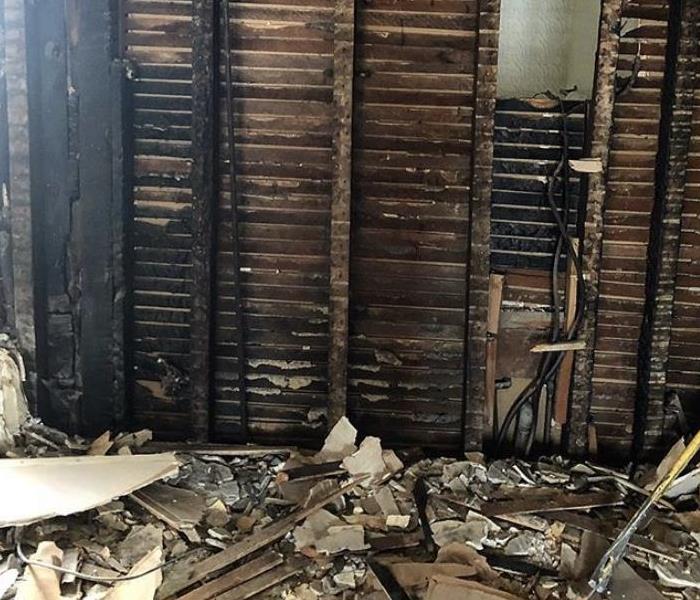
Electrical fire resulted into burnt down home in Arcadia, Ca. Luckily for the homeowner no one was in the home at the time of the fire. The fire began in the kitchen and spread throughout the rest of the first floor of the home. Household fires are extremely devastating especially if they aren't contained or dealt with quickly. The kitchen is the most common place for a fire to begin. Your stove and your oven are two big potential fire sources because they generate a lot of heat whether it be from gas or electricity. Some contributing factors that can trigger a kitchen fire are technical malfunctions, cleanliness, gas ovens and electrical ovens. In this case the fire was caused from a faulty socket that the stove was plugged into causing the circuit breaker to spark and ignite flames. SERVPRO of San Gabriel technicians worked thoroughly they came and cleaned up and removed affected area. The home owner couldn't be anymore pleased. His exact words where; "Thank you SERVPRO, thank you for servicing my home and leaving it as good as new. More beautiful than ever before."
Massive fire damage in El Monte, CA
12/9/2019 (Permalink)
One of the next most common causes of residential fires is electrical malfunction. Though it may seem like electrical malfunction is unavoidable, there are a number of bad habits that can be corrected to better your chances of escaping this catastrophe. Unfortunately for the residents of this El Monte apartment building this was definitely unavoidable. The cause of the fire still remains unknown, but after inspection it is seeming that it was more than likely a faulty cord or power socket. Here are tips to help avoid and or prevent electrical fires:
- Make sure all electric outlets are "up to par," not loose, wired properly and covered when not in use
- Make sure you never use a cable where the third ground prong has been removed
- Never use extension cords as permanent solutions and make sure all permanent cords are in-tact and not frayed or damaged
Be aware and be careful and always make sure cords do not have wiring exposed prior to use.
What steps will CAL FIRE take to engage communities and inform the public?
9/19/2019 (Permalink)
CAL FIRE continues to partner with numerous organizations to educate the public about fire prevention and safe practices through social media, community meetings, fairs and other events. CAL FIRE units also educate and inform the public about prescribed burn projects in local areas through social media and community events.
In addition, CAL FIRE will work with the Forest Management Task Force to develop coordinated messaging on public education campaigns, including coordinated messaging for Cal Volunteers and Office of Emergency Services grants consistent with AB 72 enacted earlier this year.
2019 Cal Fire Fact Sheet.
Identifying Fire Hazards in the Home
8/27/2019 (Permalink)
Who wants to think about the possibility of seeing their home damaged by fire? Unfortunately, it’s a harsh reality for too many Americans.
One way you can protect your home is to understand fire hazards and know how to identify them. In this blog, we’ll be discussing two of the most common household fire hazards.
According to the National Fire Protection Association, over a five-year period from 2011 to 2015, fire departments in the United States answered approximately 8,700 home structure fires a year that were started by candles. These were responsible for a total of 82 deaths, 800 injuries and $295 million in direct property damage.
When burning a candle, be sure it’s safely kept at least one foot away from anything flammable and is in a sturdy holder that won’t easily tip over. Never use a candle where oxygen is used in the home and always blow all candles out before leaving a room or going to sleep.
Candles were a cause of 2 percent of home fires, with 3 percent resulting in death and 7 percent resulting in injuries. There were an average of 24 home candle fires reported per day during those five years, with December the prime time of the year for home candle fires.
Of all the candle fires during this time span, 37 percent started in bedrooms and were responsible for 36 percent of the associated deaths and 51 percent of the associated injuries.
While cooking may be the leading cause of home fires, smoking is the leading cause of home fire deaths. In 2014, an estimated 17,200 home structure fires caused by smoking were reported. Those fires resulted in 570 deaths, 1,140 injuries and $426 million in property damage, per the Coalition for Fire-Safe Cigarettes.
Douse all cigarette butts and ashes in water or sand prior to throwing them out, and keep in mind that one out of four fatal victims from smoking-related fires is not the smoker whose cigarette started the fire.
If you’re a smoker, it is safest to smoke outside, as most deaths result from fires that start in living rooms, family rooms or bedrooms. Fire-safe cigarettes are a great option—and a deep, sturdy ashtray should be used.
<h4are-lesser-known-fire-hazards-to-watch-for">Here Are Lesser-known Fire Hazards to Watch For
While candles and smoking are two of the most common causes of home structure fires, there are also other lesser-known hazards that could be present in your home.
Did you know that there is glassware you may have in your home that could actually pose a fire risk? When sunlight passes through them, the concentrated ray could ignite flammable materials. It’s best to move glass accessories away from windows.
Also, look out for loose outlets in your home. Movement of these electrical outlets could loosen wires connected to the outlet and create dangerous arcing.
Dust bunnies are also a fire risk when collecting near electrical sockets and floor heaters. Sweeping or vacuuming your floors regularly and cleaning hard-to-reach areas like behind entertainment systems can help prevent buildup.
Fire, smoke and water damage can be devastating to homes, including the damage caused by firefighting efforts. SERVPRO® of San Gabriel has your back and is here to help restore your home to pre-fire condition.
3 Fire Safety Basics for the Whole Family | SERVPRO® of San Gabriel
8/27/2019 (Permalink)
Were you aware that every year in the United States, more than 350,000 house fires occur, amounting to more than $5.5 billion in property damage? These fires are also responsible for almost 3,000 deaths and another 10,000 injuries.
Advance preparation is your best defense against a fire. The importance of every person in your family knowing how to prevent fires and how to respond if they occur cannot be understated.
Start by teaching your kids basic fire safety guidelines early in their life. Take a look, as a family, at three fire safety suggestions you can practice:
Include Your Family in Fire Safety PlanningPlans should be in place in the event of a fire. Every family member needs to know that plan and what to do. This includes how to get out of the house and a safe place to meet once they’ve gotten out.
But don’t just create a plan and stop there.
Conduct fire drills on a regular basis. Practice makes perfect. This helps everyone remember the plan if an actual fire breaks out.
Catch Fire HazardsWould you be surprised if you were to take a look through your home and found fire hazards? Be sure to look through every room as well as your outdoor space checking for hazards.
- Appliances should be in good working condition.
- Electrical cords should not be frayed or damaged.
- Outlets and/or extension cords should not be “maxed out.”
- Proper wattage light bulbs should be used in light fixtures.
- Electrical wiring should not covered up by rugs or carpet.
Practice Kitchen Fire SafetyDid you know cooking is one of the major causes of house fires? That’s why it’s important to be cautious in the kitchen.
All cooks should follow basic cooking safety rules:
- Never cook when tired or distracted.
- Kids and teens need to be supervised when they cook.
- Keeping a lid nearby when cooking with grease on the stove helps in the event of a grease fire. Should a small grease fire occur, use the lid to cover and smother it.
- Turn the oven off and do not open the door if the oven catches fire.
- If a kitchen fire is spreading, immediately leave the room, closing the door.
If your family has experienced a fire and needs help restoring your home, SERVPRO® of San Gabriel can help! Give us call to learn about our fire restoration services and what we can do for you.
Actions to Take for House Fire Prevention | SERVPRO® of San Gabriel
8/6/2019 (Permalink)
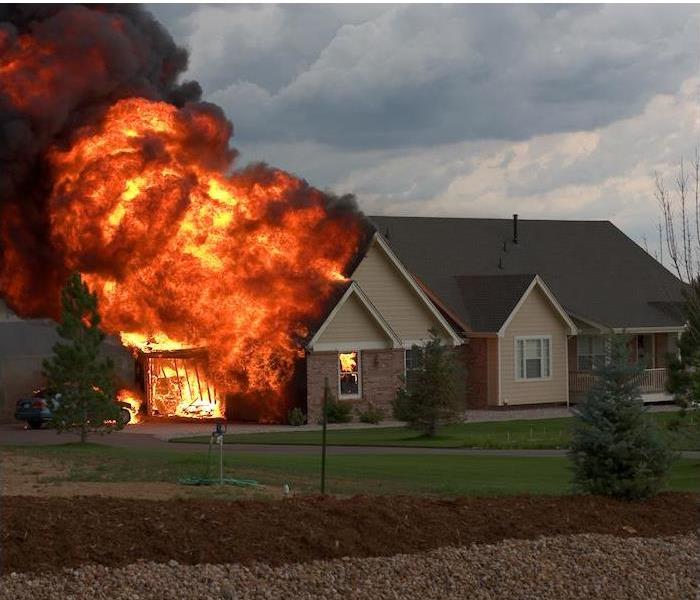 House fires are dangerous and damaging, but most are not aware of just how widespread they are
House fires are dangerous and damaging, but most are not aware of just how widespread they are
House fires are dangerous and damaging, but most are not aware of just how widespread they are—and how preventable. While there are no guaranteed ways to ensure a house fire will never occur, there are ways to lessen the chances.
Statistics About House Fire FrequencyThe regularity that house fires occur is alarming—the NFPA reports that a fire is called in over twice every 60 seconds.
Because many people cook with gas stoves each day, it is logical that the number one cause of residential fires is cooking. Unfortunately, there are many other things to be wary of surrounding house fires.
Actions for House Fire PreventionFlames can spread rapidly once they begin, which is why it is best to stop them from occurring in the first place. These actions you can take to prevent house fires will keep flames from starting and growing out of control:
Battery tests for smoke detectors. It only takes a moment to test your smoke alarm batteries via the button on the unit. It is recommended that a test is performed every month.
Clearing the tray of the dryer. Though they are an everyday appliance, dryers can be a fire hazard as well. As they heat up, lint in the dryer tray can spark and catch fire if not cleared out.
Being careful of open flames. Even if a fire starts out contained, such as for cooking or heat, it can easily jump to other surfaces if the conditions are right. It is recommended to never leave open flames unattended, no matter for how short of a time.
Checking cables. Any cable that carries electricity can become a fire hazard if frayed or worn. Check cords often for signs of wear and replace if necessary.
Proper household chemical storage. A surprising amount of things under the kitchen sink can be highly flammable. Check the labels of each product for storage instructions and keep combustible materials away from heat.
If your home has suffered damage from a house fire, give us a call. We are certified in fire and soot remediation, and here to help 24⁄7.
Fire Safety Tips for Your Business
4/25/2019 (Permalink)
As a business owner, there are plenty of safety considerations to address regarding risks to your business, staff and visitors. One of the things you need to spend a little extra time planning for and working toward is fire prevention.
According to the National Fire Protection Association (NFPA) listed in order:
- Cooking equipment, 29% of fires
- Electrical distribution and lighting equipment, 12% of fires
- Heating equipment, 11% of fires
- Intentional, 10% of fires
- Smoking materials, 9% of fires
- Exposure, 4% of fires
- Electronic, office or entertainment equipment, 3% of fires
From those cases, three of them—intentional, exposure, and electrical distribution and lighting equipment—accounted for 20%, 18% and 15%, respectively, of the most property damage.
The Bureau of Labor Statistics found that in 2007, fires and explosions accounted for 3% of all workplace fatalities.
In taking a looking at more recent numbers, the NFPA estimates that from 2007–2011, U.S. fire departments responded to an average of 3,340 fires in office properties per year, which were responsible for an annual average of four deaths, 44 injuries and $112 million in direct property damage.
Tips for Protecting Your Business
What can you, as a business owner, do to protect your business from the risk of fires?
First, you must assess your risk for fire by identifying hazards. In some areas, the local government may even offer a visit from a fire marshal to help identify these risks and provide guidance on your fire prevention plan.
You’ll want to make sure that the right fire protection equipment is in place. This includes an automatic sprinkler system, smoke detectors and fire extinguishers on each floor.
Finally, work on creating a fire plan and reviewing it with your staff. That way you’ll be making sure everyone knows what to do and how to stay safe in the event of a fire. Conduct fire drills at least once a year to keep the fire safety protocol fresh, and take time to review evacuation plans and the location of your first-aid kits.
Despite best efforts with fire prevention and safety tips, the worst could always happen at your business. If a fire has damaged your business, SERVPRO® of San Gabriel is the team to call.
Preventing Fire
7/9/2018 (Permalink)
Preventing Fire
SERVPRO of San Gabriel specializes in Fire Mitigation as well as Fire Restoration. Fire damage is a homeowner's biggest worry. In the modern world we have endless appliances to assist our daily living; however, they also pose a great danger if not properly maintained or applied. Here are some common causes of fire as explained by Traveler's Ins.
Alternative Heating Sources May Also Create a Fire Hazard. Do not place a space heater near furniture, curtains or other objects that could easily catch fire. Clothes Dryers Are Another Common Source of House Fires. Clean out the dryer vent regularly. Clean out the lint filter after each load. Lint may also collect under and behind your dryer, so do not forget to clean these areas. Carelessness in the Kitchen May Also Lead to a House Fire. Keep a kitchen fire extinguisher readily available and know how to use it. Keep your stove and oven clean. Built up food splatter or grease can later ignite when the stove or oven is turned on for cooking. Faulty Wiring and Outlets Are One of the Top Causes of House Fires. Check the electrical cords throughout your home for signs of fraying, and replace all frayed wires.
Source: ternative Heating Sources May Also Create a Fire Hazard. Do not place a space heater near furniture, curtains or other objects that could easily catch fire. Clothes Dryers Are Another Common Source of House Fires. Clean out the dryer vent regularly. Clean out the lint filter after each load. Lint may also collect under and behind your dryer, so do not forget to clean these areas. Carelessness in the Kitchen May Also Lead to a House Fire. Keep a kitchen fire extinguisher readily available and know how to use it. Keep your stove and oven clean. Built up food splatter or grease can later ignite when the stove or oven is turned on for cooking. Faulty Wiring and Outlets Are One of the Top Causes of House Fires. Check the electrical cords throughout your home for signs of fraying, and replace all frayed wires.
Source: https://www.travelers.com/resources/home/fire-safety/how-to-prevent-house-fires





 24/7 Emergency Service
24/7 Emergency Service
